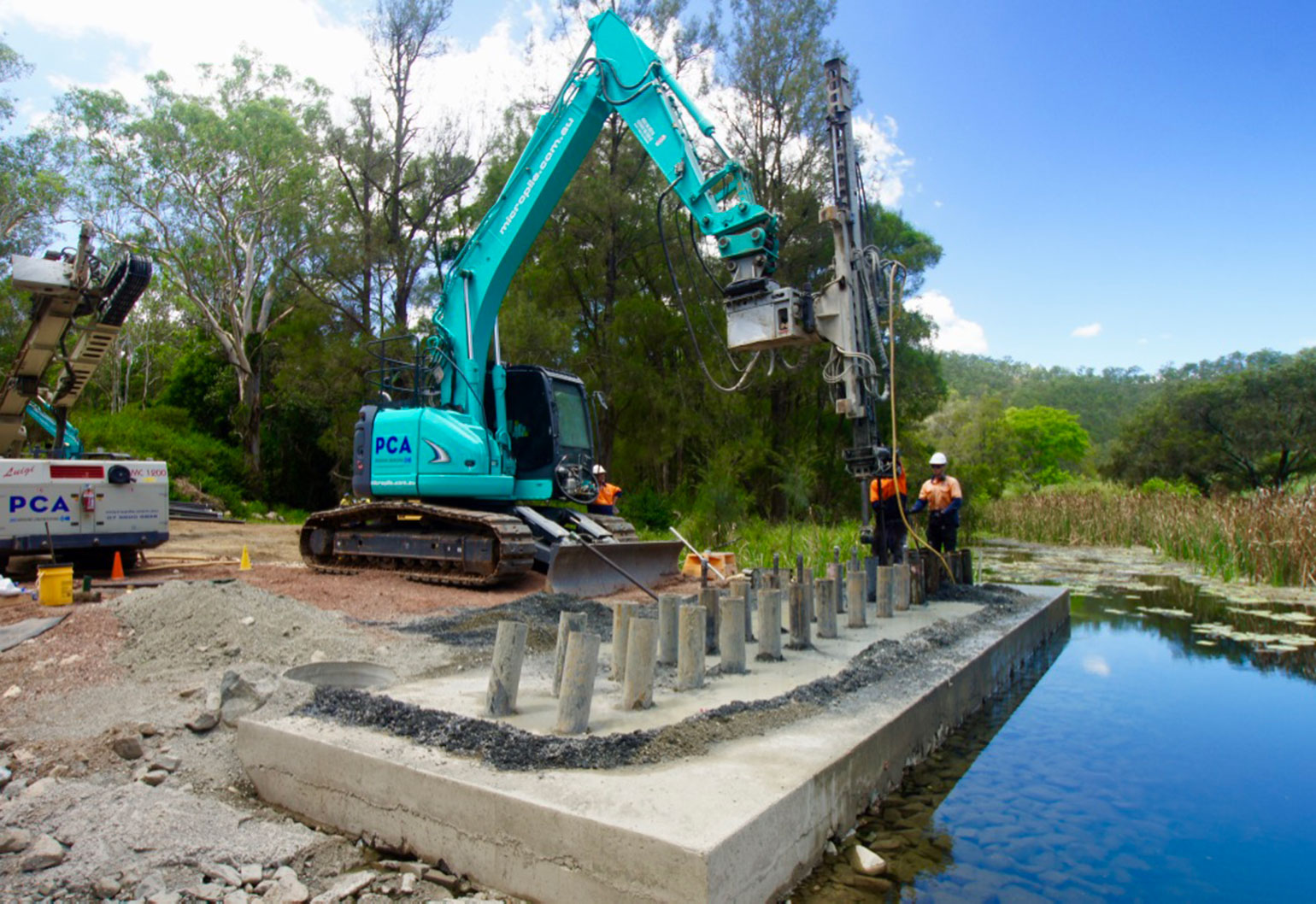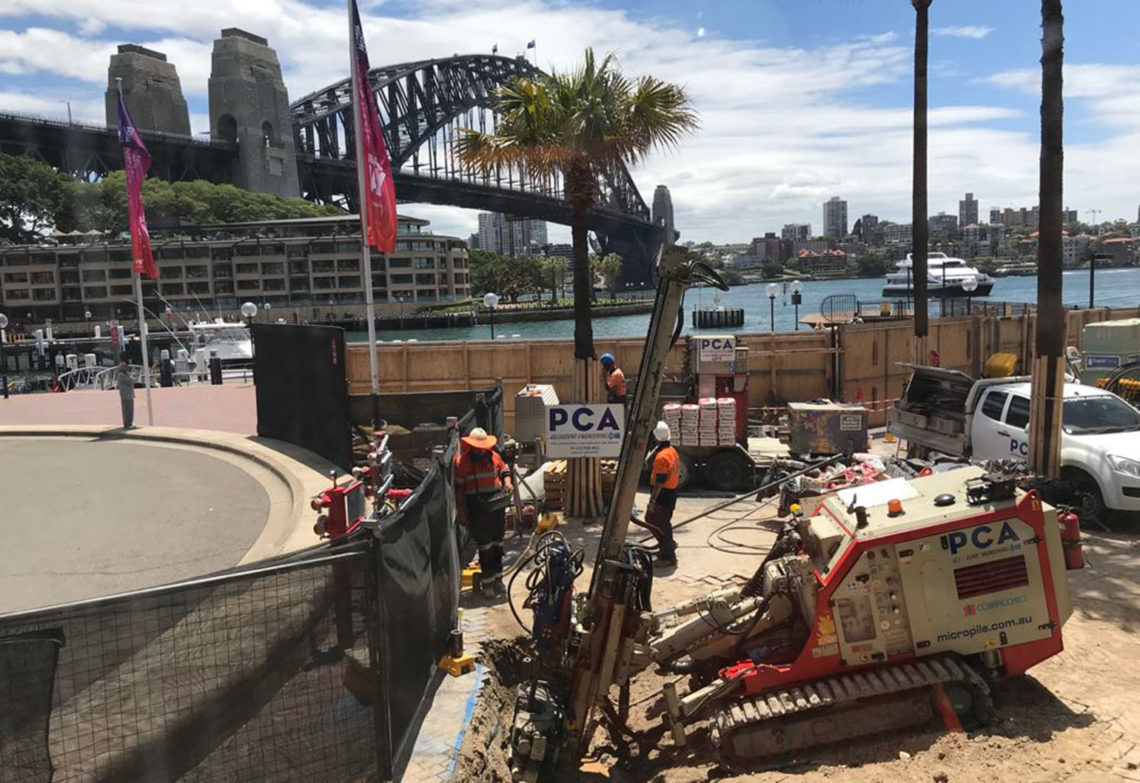The International Workshop for Micropiles comes to Australia for the first time this August. PCA Ground Engineering, Australia’s micropiling specialists, spoke with us about what this technology has to offer Australian engineers.
After a series of significant rain events in Queensland, the Department of Transport and Main Roads (TMR) was developing a project to improve slope stability below a regional artery. The original plan was to use traditional bored piles, which are wide-diameter foundation elements made from concrete and steel casings cast deep into a hillside.
In order to support the piling rig on the site, temporary works in the form of micropiles were required. Connected to steel plates on which the piling rig could safely operate, they would provide a temporary foundation while the road was closed for the duration of the work.
The financial cost and time to carry out the temporary works to support the piling rig was significant and the project managers soon realised they could instead use micropiling for the entire venture, rather than just part of it. This decision brought the project in early and well under budget and won both a TMR award for innovation and the national Civil Contractors Federation Earth Award for excellence.
Another benefit was that the small size of the micropiling rig meant that only one traffic lane had to be closed – rather than the entire road being shut down.
PCA Ground Engineering, the firm that designed and carried out the micropiling work, recently completed another job in Canberra at the Japanese consulate. Officials were looking at renovations to the existing building , which would require reinforced foundations.
“We went in there with our portable equipment, which fitted through their doors, and we worked in their hallways installing micropiles,” said Allan Herse, Director and Engineering Manager of PCA Ground Engineering.
“At PCA, we started out simply trying to bring modern micropile technology into Australia. Now we have clients who are working with us to carry out projects that were once deemed too hard, too expensive or just plain impossible without micropiles.. They’re a very powerful tool for an engineer to have in their toolbox.
Herse spoke with create about why micropiles have a big future in Australia.

create: What exactly are micropiles?
ALLAN HERSE: Think of micropiles as tree roots. A tree is extremely heavy and takes a lot of load from a lot of different directions, but it doesn’t have a bulky pile or foundation. Instead it has small roots that allow it to resist the loads.
create: What types of applications do micropiles suit?
AH: They cover a large range of applications. Slope stability is a big one. If a road authority has a road that is about to disappear down a hill, micropiles are often an excellent solution. Micropiles also work for projects that have access or heritage restrictions; we have rigs that we can walk through the front door of your house to drill through your slab. They’re also useful on larger engineering projects such as bridge foundations.
We have completed several bridge foundations that would typically have large-diameter bored piles and we’re replacing those with an array of 16 to 18 micropiles in the same area. So we’re creating cement grout and steel tree roots rather than requiring heavy, engineered elements.
create: Why might micropiling be chosen over traditional methods?
AH: Apart from access, drilling traditional piles inherently comes with risk because you might come across boulders or other natural obstructions, for instance. With a standard piling rig, that could bring things to a grinding halt with costly variations.
But with micropiles, we’re already using rock drill technology, so we just go through it. We’re not concerned about what we find underground.
create: Is micropiling the best choice in all piling situations?
AH: No, micropiles are simply one tool. If you have a job without access issues that involves boring into very clean soils, for example, then bored piles or CFA piles could be a better choice which is why PCA also has several traditional piling rigs.
create: Where in the world is micropiling a common engineering solution?
AH: We don’t really have a micropiling industry in Australia – yet. In North America and Europe, micropiling is at least 30 per cent of the marketplace and growing.
create: Why is it uncommon in Australia?
AH: The Australian standard for piles doesn’t have anything to cover micropiles. We have to defer to overseas specifications from bodies like the Federal Highways Administration in the US, or EN 14199 from Europe.
When you’re an engineer and designing something for TMR or RMS [Roads and Maritime Services] or VicRoads, then you’ve only got a certain number of tools in your toolbox. Currently, micropiles isn’t one of them. We’re a little behind the times but catching up fast.
create: How important is the International Workshop for Micropiles to raising awareness about this solution?
AH: It will be a gathering of the world’s leaders in micropiling for a workshop, not a conference. Yes, there will be technical papers and case studies, but everyone will have the ability to personally meet and speak with the greatest minds in this area. Experts are coming from Korea, Canada, the US, India, the UK, South America, Austria, Poland and more.
We’d expect great attendance from Australian civil and structural engineers and anybody from a geotechnical background. It will be very useful for those from road and transport departments and anybody dealing with roads, bridges or slope stability. It will also be valuable for those working in organisations such as utilities that have existing public assets that could need future life extensions and therefore require foundation work.
PCA Ground Engineering will be hosting the 14th annual International Workshop for Micropiles on the Gold Coast, Queensland 21-23 August. To learn more about micropiling technology and to register, click here.




I fully agree with Allan Herse. Micropiles are not the solution for all problems but can help in many cases. I am already looking forward to Q&A and interesting discussion on mircopiles. On the other side of the world (Austria) we are working since the eighties of the past century but we still have to argue why micropiles….